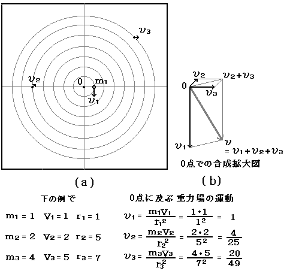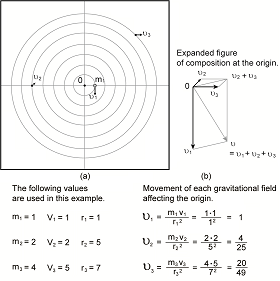下図は各天体の重力場の運動がO点にどれほど影響しているかを示します。
その下の表はこの例での計算式、右図のυ1、υ2 、 υ3 はその合成を拡大して示したものです。
第3図
第2図にある天体m3を例にとりますと、O点から距離7r1にある質点m3のつくる重力場がO点に及ぼす重力場の強さは、ニュートンの万有引力の法則から、m1のそれに比べ1/(7r1)2になるでありましょう。質量m3がm1の4倍だとしますと、その運動速度V3がO点に及ぼしている影響はV3×4m1/(7r1)2となると考え、この値をυ3とします。
これはm1による重力場運動に対し、どれほどの比になるかをみますと、まずm1がO点に及ぼす速さは、さきのような計算で、υ1=V1×m1/r12ということになります。
つぎに、さっきのV3がm1のもつ速さV1の5倍あるとしますと、υ3は
υ3=5V1×4m1/(7r1)2
と表わせます。υ1に対する絶対値の比をとってみますと
υ3/υ1
=[5V1×4m1/(7 r1) 2]/[V1×m1/r12]
従ってυ3をυ1で表わしますと
υ3=[5×4×r12/(7r1)2]υ1
=[5×4/49]υ1
となります。第3図、下の表でυ1=1×υ1としますと、υ3は
υ3=(20/49)υ1です。The following figure shows the influence that the movement of the gravitational field of each celestial body exerts on the origin (arbitrary point to investigate). The table shows the calculation formulae for this example. On the right, the compositions of υ1, υ2 and υ3 are shown in expanded form.
Figure 3
The strength of exertion from the gravitational field generated by a point mass, m3 (at a distance of 7 r 1 from the origin) on the origin would be, from Newton’s law of universal gravitation, 1/(7r1)2 compared with that of m1. If the mass of m3 is four times that of m1, then the influence that speed V3 exerts on the origin would be V3 × 4 m1/(7r1)2. This value is υ3. Now consider how this compares, as a ratio, to the gravitational movement of m1. First, the effect that the speed of m1 has on the origin is similarly calculated as υ1 = V1 × m1 / r 12.
If the earlier speed V3 is five times that of V1 (where V1 is the speed of m1), then υ3 can be expressed as follows:
υ3 = 5V1 × 4m1 / (7r1)2
The ratio of the absolute values with respect to υ1 results in
υ3/ υ1= [5 V1 × 4m1/(7r1)2] / [V1 × m1/r12]Thus, expressing v3 in terms of υ1,
υ3 = [5 × 4 × r12 / (7r1)2] υ1
= [5 × 4 / 49] υ1
In the table in Figure 3, if υ1=1 × υ1, then υ3 would be
υ3 = (20 / 49) υ1.

